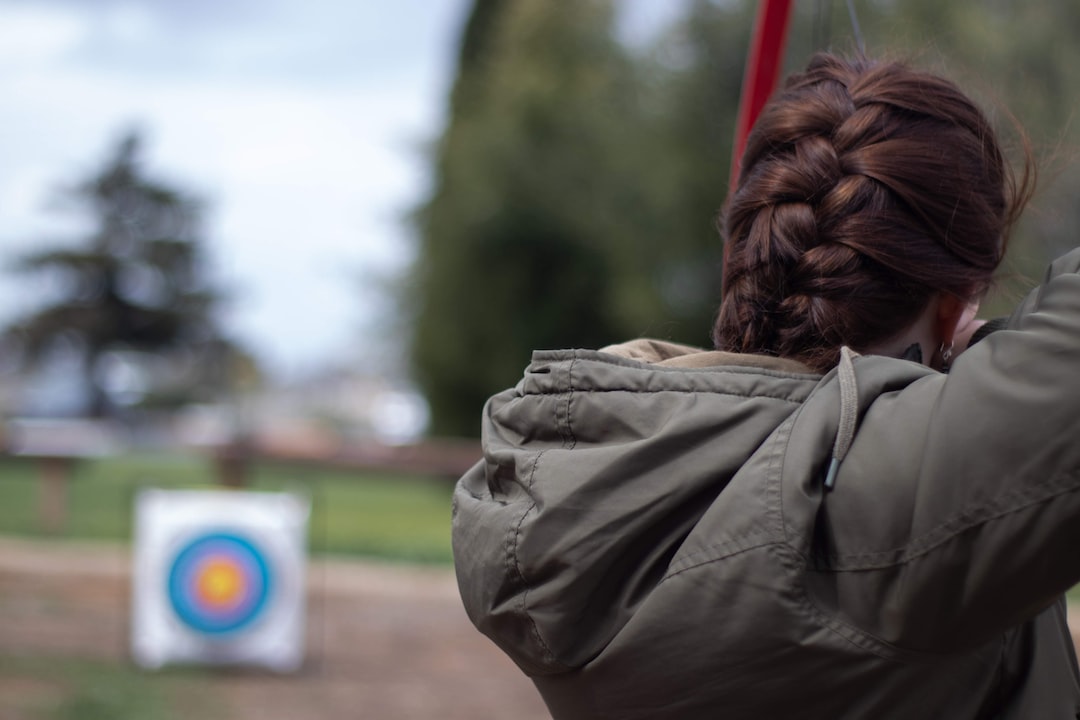Are you a bowhunter looking for the best archery target?
There are so many different types of targets and materials available that it can be overwhelming.
From the impact of practice broadheads to popular brands, expensive vs affordable options and more – there’s no one-size fits all when it comes to choosing the best archery target. We’ll take a look at each type of target, what they are made from, how weatherproof they are and which ones will suit your needs in this blog post.
So, if you’re curious to discover which archery target is optimal for your requirements, peruse the following…
Types of Archery Targets
Archers have an array of target shapes and sizes to pick from, each with its own pros and cons. 3D targets are the most realistic option for archers looking to hone their skills on life-like game animals.
These targets usually feature detailed designs that mimic the shape and size of real-life animals like deer, elk, or turkey. They’re also great for practicing shots at various angles since they can be positioned in different positions around the range.
A drawback, however, is the greater expense associated with some of these targets when compared to others.
Foam block targets are an affordable alternative to 3D models and offer a good amount of durability while still providing plenty of challenge for experienced shooters.
Foam blocks come in a range of sizes and shapes, allowing you to pick the ideal one for your shooting needs. Foam blocks are often used by hunters who want to practice shooting from tree stands or ground blinds since they provide an excellent backdrop for simulating those scenarios without having to leave home.
However, foam blocks don’t offer much realism when it comes to replicating actual hunting conditions since there isn’t any movement involved with these types of targets.
When it comes to archery targets, there are a variety of options available that can help you improve your shooting skills. From 3D targets to foam block and paper targets, each offers its own unique benefits. To get the most out of your practice sessions, it is important to also consider using practice broadheads such as fixed blade or mechanical broadheads.
Practice Broadheads
Practice broadheads are an important part of any archer’s arsenal. They allow you to hone your skills and become a better shot without risking damage to expensive hunting arrows or targets. There are two main types of practice broadheads: fixed blade and mechanical.
Fixed blade broadheads feature a single, solid steel blade that is designed for maximum penetration into the target material. The best fixed blade broadheads pack a punch – they have super sharp cutting abilities with a lot of weight and no moving parts to lose energy.
Different shapes and sizes of these blades exist, enabling you to pick one that fits your shooting style and needs. Fixed blade broadheads are generally more durable than their mechanical counterparts, but they also require more force when being shot from the bow due to their weight.
Mechanical broadheads feature multiple blades which open up upon impact with the target material, creating a larger wound channel than traditional fixed-blade designs can provide. The best mechanical broadheads will reliably open on impact every time to ensure maximum damage and power.
The blades on these heads are typically made from lightweight materials such as aluminum or carbon fiber which makes them easier to shoot from the bow at higher speeds while still providing enough penetration power for effective practice sessions.
However, because of their lighter construction they may not be as durable as fixed-blade models over time if used frequently during practice sessions.
Both types of practice broadheads have advantages and disadvantages depending on what type of shooting you plan on doing most often with them. However, both offer excellent performance when it comes to honing your skills without damaging expensive equipment or targets in the process.
Practice broadheads are essential for honing your skills and improving accuracy, so be sure to choose the right one that meets your needs before you move on to selecting an archery target.
Popular Archery Target Brands
Rinehart Targets:
Rinehart Targets are known for their long-lasting, durable construction and realistic 3D designs. They feature self-healing foam that can withstand thousands of shots from both field points and broadheads.
The company also offers a variety of different target sizes to suit any archer’s needs. Their targets come in two main categories; traditional archery targets and 3D animal targets, which are perfect for hunting practice or recreational shooting.
Delta McKenzie Targets:
Delta McKenzie Targets offer an extensive range of archery targets made from high-density foam with replaceable cores for extended use. They have a wide selection of block, bag, paper, and 3D animal targets available in various sizes and shapes to fit the needs of any shooter.
Their unique “TuffCore” technology ensures maximum durability even after hundreds of shots while still providing excellent stopping power on arrows shot at close range.
Field Logic Targets:
Field Logic Targets provide shooters with some of the most advanced target systems on the market today. These include everything from simple paper target faces to full size 3D animals complete with lifelike features such as fur textures and natural colors that make them look just like real game animals when viewed up close.
Field Logic also has a line of bow stands designed specifically for their large format targets, allowing you to set up your own shooting range right in your backyard.
For the hunter looking to hone their archery skills, there are a variety of popular target brands available. From Rinehart Targets to Delta McKenzie and Field Logic Targets, each brand offers unique features that can help make your practice more successful.
Now let’s look at the pros and cons of investing in an expensive vs affordable archery target.
Expensive vs Affordable Archery Targets
When it comes to archery targets, there are two main categories: expensive and affordable. Before deciding which type of target is best for you, there are a few factors to consider.
Size is a factor of great consequence when selecting an archery target; whether you’re aiming for long-distance accuracy or just need something that can withstand the elements, it’s important to choose wisely. If you plan on shooting at longer distances, then a larger target may be necessary in order to accurately measure your accuracy and progress over time. Make sure you start out by sighting in your bow the right way.
The kind of material used in the making of a target can impact its resilience and how well it can cope with inclement weather, such as rain or snow.
Weatherproofing considerations should also be taken into account when selecting an archery target since some materials will hold up better than others in certain climates or environments.
Expensive archery targets typically offer more features than their affordable counterparts but they come with a higher price tag too. These types of targets often feature multiple layers of foam padding that provide superior stopping power for arrows while still allowing them to penetrate deeply enough for easy retrieval after each shot.
They’re usually made from high-quality materials that are designed to last longer and stand up against wear and tear from repeated use over time without showing signs of damage or degradation quickly like cheaper models might do if not properly cared for regularly.
Expensive targets also tend to have more detailed designs that make them look great even when placed outdoors where they can be seen by passersby who may take notice and appreciate the craftsmanship put into making these pieces of equipment so attractive yet functional at the same time.
A high-quality target will typically endure more use and provide easier arrow removal.
Affordable archery targets generally offer fewer features than their expensive counterparts, but they come with a much lower price tag. These types of shooting targets typically feature less layers of foam padding which means arrows won’t penetrate as deeply, making arrow removal slightly more difficult after each shot.
Moreover, these models are typically crafted with materials that may not be as resilient and could fail to endure regular usage unless the proper maintenance is done regularly to defend them from weather conditions like wind or rain.
In conclusion, whether you choose an expensive or affordable model depends largely upon your budget constraints along with other factors such as size needed (if any), desired features offered by either option available (if any) etc.
Ultimately though, both types serve similar purposes albeit in different ways – providing users with quality practice sessions while out hunting game animals during season times – just make sure whatever route chosen fits within financial means first before anything else.
Considering the various aspects discussed in this article, it is essential to assess which type of material will most effectively meet your requirements when selecting between an extravagant or inexpensive archery target. Moving on, let’s discuss the materials used in archery target construction and how they can impact durability and weatherproofing.
Materials Used in Archery Target Construction
Archery target construction requires the use of a variety of materials. Foam and plastic materials are often used to create targets that can withstand multiple shots from arrows. These materials provide excellent durability, making them ideal for outdoor shooting purposes. Foam is lightweight and provides superior shock absorption, while plastic offers more rigidity and protection against weathering.
Wood and metal materials are also commonly used in archery target construction due to their strength and durability. Wood is an excellent choice for creating targets that will last through many uses, as it is both strong and lightweight. Metal can be used to reinforce wood or foam targets, providing additional stability when shooting at longer distances or with higher draw weights on bows.
Weatherproofing considerations should also be taken into account when constructing archery targets out of any material. It is essential to ensure all components are safeguarded from wet conditions if the target will be left outdoors, so that they won’t become sodden or weakened by moisture over time.
For example, foam blocks should have a sealant applied around the edges before being placed outside in order to prevent water damage from occurring during rainstorms or other inclement weather events.
Similarly, wooden frames should be treated with a waterproof sealant prior to installation outdoors so they remain protected from moisture-related issues such as rot or warping over time due to exposure to dampness or humidity levels in the air surrounding them.
FAQs in Relation to Best Archery Target
What is a good target for archery?
A good target for archery depends on the skill level of the shooter. For beginners, foam targets are great because they provide a large surface area to practice aiming and shooting. More experienced shooters may want to invest in 3D targets which look like animals and require more precise aim.
Regardless of your skill level, it is important to choose a target that can withstand repeated shots from your bow without breaking or becoming damaged. Moreover, it is essential to opt for a target that can offer the necessary resistance so as to enable you to practice shooting with the same force and accuracy like in an actual hunting situation.
How far can an archer shoot accurately?
The response to this inquiry fluctuates, contingent upon an assortment of components – from the kind of bow utilized and the archer’s aptitude level to natural conditions. Generally speaking, an experienced archer with a modern compound bow can accurately shoot up to 80 yards in ideal conditions.
However, for most recreational archers shooting at distances beyond 40-50 yards is considered challenging due to increased difficulty in accuracy. In addition, windy or rainy weather can significantly reduce an archer’s effective range.
Ultimately it is important for any serious hunter or sportsman to practice regularly in order to increase their accuracy and distance capabilities.
What target is best for broadheads?
No single choice is the definitive answer for selecting the optimum target for broadheads. Different targets are designed for different types of shooting and hunting scenarios. For instance, a foam block target may be suitable for recreational practice shooting, while a bag or 3D animal target might be better suited for field point accuracy testing or hunting preparation.
Ultimately, the type of target you opt for should be contingent upon your personal aims and ambitions as a shooter or hunter. Consider factors such as arrow penetration depth, durability, portability and cost when selecting the right target material for your purposes.
What are most archery targets made of?
Most archery targets are made of foam, paper, cardboard, or straw.
Foam is the most popular material for archery targets because it is lightweight and durable. It also absorbs arrows well and can be used in both indoor and outdoor settings.
Paper targets are usually printed on thick cardstock that stands up to repeated shots from a bow. Cardboard targets provide an economical option but may not last as long as other materials. Finally, straw-filled bags offer a great way to practice shooting at different distances without having to buy multiple types of target material.
Conclusion
When it comes to choosing the best archery target, there are many factors to consider. From types of targets and practice broadheads to popular brands and materials used in construction, you’ll want to make sure you choose one that fits your needs.
If you are a new archery hunter and looking for your first practice target to put in the reps, start with an inexpensive but larger target until you get the hang of it.
Expensive or affordable, weatherproof or not – all these things should be taken into account when deciding on the best archery target for your hunting adventures. Figuring out which target is best suited for you can be tricky, but with some research and understanding of the various possibilities, you’re sure to find something that fits your needs.



